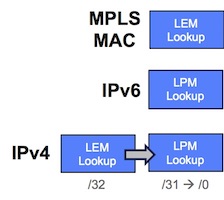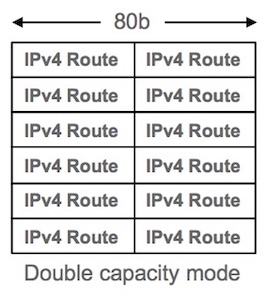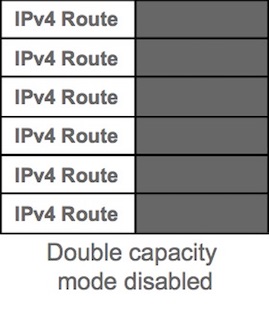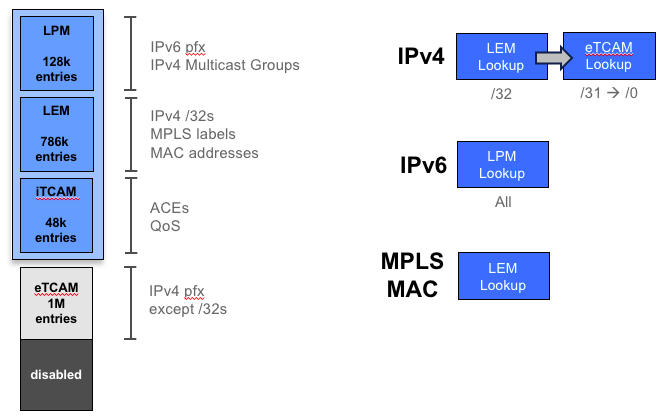NCS5500 URPF: Configuration and Impact on Scale
You can find more content related to NCS5500 including routing memory management, VRF, ACLs, Netflow following this link.
Edited in August 2018 to add a note on the lack of support of S-RTBH, and to fix an error pointed by Muffadal Presswala (thanks :) related to the behavior with eTCAM systems.
S01E07 NCS5500 URPF Configuration and Impact on Scale
Previously on “Understanding NCS5500 Resources”
In previous posts, we presented:
- the different routers and line cards in NCS5500 portfolio
- we explained how IPv4 prefixes are sorted in LEM, LPM and eTCAM
- we covered how IPv6 prefixes are stored in the same databases.
- we demonstrated in a video how we can handle a full IPv4 and IPv6 Internet view on “Base” systems and line cards (i.e. without external TCAM, only using the LEM and LPM internal to the forwarding ASIC)
- in the fifth post, we continued with a new video where we demonstrated the very high scale we can reach on Jericho-based systems when using an external TCAM
- last post, we introduced systems based on the Jericho+ forwarding ASIC and we detailed the routing distribution between the different memories and the scale they can achieve.
In this new episode, we will cover the impact of activating URPF on the NCS5500 routers.
Definition
URPF stands for Unicast Reverse Path Forwarding.
Definition from the CCO website:
“This security feature works by enabling a router to verify the reachability of the source address in packets being forwarded. This capability can limit the appearance of spoofed addresses on a network. If the source IP address is not valid, the packet is discarded.
Unicast RPF in strict mode, the packet must be received on the interface that the router would use to forward the return packet.
Unicast RPF in loose mode, the source address must appear in the routing table.”
It’s a feature configured at the interface level.
URPF relevancy
Regardless of the Forwarding ASIC (Qumran-MX, Jericho or Jericho+), the NCS5500 only supports URPF in loose mode today.
Configuring URPF comes at a cost in term of scale on some of the NCS5500 family members. It will be detailed extensively in this article. That’s why it’s important to understand what are the benefits of enabling this feature.
As explained in the definition section above, the loose mode simply verify that source addresses of the packets received are in of the routable space. To bypass this “protection”, it’s fairly easy for an attacker to pick source addresses inside existing routes when forging the packet instead of totally random addresses.
We invite the operators to check how much traffic is currently dropped by the URPF loose mode if they have it enabled on production routers.
Example: to check this on an ASR9000:
RP/0/RP0/CPU0:Router#show cef drops | i RPF drops
RPF drops packets : 0
RPF drops packets : 0
RPF drops packets : 0
RPF drops packets : 0
RPF drops packets : 0
RPF drops packets : 0
RPF drops packets : 0
RPF drops packets : 0
RPF drops packets : 50065
RPF drops packets : 0
RPF drops packets : 1262
RPF drops packets : 3627918
RPF drops packets : 1262
-- SNIP --
And compare these figures to the packet count per interface to understand how much traffic it represents. The impact it could have on route scale and the protection efficiency it offers need to be put in perspective before deciding if it is worth enabling URPF.
Now said, some other very good reasons to enable URPF loose mode exist. For example, it’s a mandatory brick of a Source-based Remotely Triggered Black Hole architecture (S-RTBH).
But… S-RTBH is not supported currently on NCS5500 (even if the URPF loose-mode is supported, it can not be used for this particular use-case). It will be fixed in a future release.
NCS5500 Implementation
We don’t support URPF strict mode today. URPF loose mode is available on NCS5500 since IOS XR 6.2.2 for IPv4 and IPv6. The feature is supported on Jericho and Jericho+ systems, with or without eTCAM.
The configuration implies the deactivation of some profiles, different on “base” and “scale” systems. After this preliminary operation, the configuration is applied at the interface level.
Deactivating URPF on an interface implies to do it for both IPv4 and IPv6.
Allow-self-ping is the default mode and allow-default is not supported.
Configuration and impact on base systems (no eTCAM)
On “base” systems (without external TCAM):
Since URPF requires two accesses to the LEM (lookup for source address then for destination address in the packet header), we have to disable the optimizations present by default or after a configuration:
hw-module fib ipv4 scale host-optimized-disable
hw-module fib ipv6 scale internet-optimized-disable
Note: depending on the IOS XR version, the options could be different and actually could be the opposite of “disable”, be attentive at what is availabe in the CLI.
With the optimization disabled and after the line cards / system reload, we have now:

Important: with such mode, it will no longer be possible to handle a full internet view (v4+v6 or v4-only).
The configuration can now be applied on the interfaces:
hw-module fib ipv4 scale host-optimized-disable
hw-module fib ipv6 scale internet-optimized-disable
!
interface HundredGigE0/7/0/0
ipv4 address 192.168.1.1 255.255.255.252
ipv4 verify unicast source reachable-via any
ipv6 verify unicast source reachable-via any
ipv6 address 2001:10:1::1/64
Configuration and impact on scale Jericho systems (with eTCAM)
Now, let’s consider the scale systems and line cards with Jericho ASICs:
The eTCAM is a 80bit memory and in normal condition we use it in two blocks of 40 bits to double the capacity. The first access being performed on the first half and the second access in the pipeline being done on the second half.

With URPF, we need these two accesses to check source and destination, it’s no longer possible to use the double capacity mode: it needs to be disabled.

RP/0/RP0/CPU0:NCS5508-632(config)#hw-module tcam fib ipv4 scaledisable
RP/0/RP0/CPU0:NCS5508-632(config)#hw-module fib ipv4 scale host-optimized-disable
RP/0/RP0/CPU0:NCS5508-632(config)#hw-module fib ipv6 scale internet-optimized-disable
RP/0/RP0/CPU0:NCS5508-632(config)#commit
The impact on scale is significative since we lost 1M out of the 2M of the eTCAM capacity.

Let’s check with a large routing table (internet v4 + internet v6 + 435k host routes) what is the impact:
RP/0/RP0/CPU0:5508-6.3.2#sh bgp sum
BGP router identifier 1.1.1.1, local AS number 100
BGP generic scan interval 60 secs
Non-stop routing is enabled
BGP table state: Active
Table ID: 0xe0000000 RD version: 1720749
BGP main routing table version 1720749
BGP NSR Initial initsync version 634456 (Reached)
BGP NSR/ISSU Sync-Group versions 1720749/0
BGP scan interval 60 secs
BGP is operating in STANDALONE mode.
Process RcvTblVer bRIB/RIB LabelVer ImportVer SendTblVer StandbyVer
Speaker 1720749 1720749 1720749 1720749 1720749 1720749
Neighbor Spk AS MsgRcvd MsgSent TblVer InQ OutQ Up/Down St/PfxRcd
192.168.100.151 0 1000 706753 307270 1720749 0 0 5w0d 655487
192.168.100.152 0 45896 707144 307270 1720749 0 0 5w0d 656126
192.168.100.153 0 7018 705342 307270 1720749 0 0 5w0d 654330
192.168.100.154 0 1836 709963 307270 1720749 0 0 5w0d 658948
192.168.100.155 0 50300 687217 307270 1720749 0 0 5w0d 636208
192.168.100.156 0 50304 708316 307270 1720749 0 0 5w0d 657301
192.168.100.157 0 57381 708322 307270 1720749 0 0 5w0d 657307
192.168.100.158 0 4608 728503 812358 1720749 0 0 5w0d 677487
192.168.100.159 0 4777 717228 307270 1720749 0 0 5w0d 666213
192.168.100.160 0 37989 339686 307270 1720749 0 0 5w0d 288706
192.168.100.161 0 3549 705390 307270 1720749 0 0 5w0d 654376
192.168.100.163 0 8757 683499 307270 1720749 0 0 5w0d 632483
192.168.100.164 0 3257 705671 307270 1720749 0 0 5w0d 654661
192.168.100.166 0 10051 1186443 217145 1720749 0 0 00:28:05 1186410
RP/0/RP0/CPU0:5508-6.3.2#sh dpa resource iproute loc 0/7/CPU0
"iproute" DPA Table (Id: 24, Scope: Global)
--------------------------------------------------
IPv4 Prefix len distribution
Prefix Actual Capacity Prefix Actual Capacity
/0 3 20 /1 0 20
/2 0 20 /3 0 20
/4 3 20 /5 0 20
/6 0 20 /7 0 20
/8 16 20 /9 14 20
/10 37 204 /11 107 409
/12 288 818 /13 557 1636
/14 1071 3275 /15 1909 5732
/16 13572 42381 /17 8005 25387
/18 14055 42585 /19 25974 86603
/20 40443 127348 /21 45082 141679
/22 83722 231968 /23 71750 207173
/24 395142 1105590 /25 2085 4299
/26 3362 4504 /27 5736 3275
/28 15909 2866 /29 17377 6961
/30 42508 2866 /31 112 204
/32 435868 20
NPU ID: NPU-0 NPU-1 NPU-2 NPU-3
In Use: 1224707 1224707 1224707 1224707
Create Requests
Total: 1224713 1224713 1224713 1224713
Success: 1224713 1224713 1224713 1224713
Delete Requests
Total: 6 6 6 6
Success: 6 6 6 6
Update Requests
Total: 341539 341539 341539 341539
Success: 341538 341538 341538 341538
EOD Requests
Total: 0 0 0 0
Success: 0 0 0 0
Errors
HW Failures: 0 0 0 0
Resolve Failures: 0 0 0 0
No memory in DB: 0 0 0 0
Not found in DB: 0 0 0 0
Exists in DB: 0 0 0 0
RP/0/RP0/CPU0:5508-6.3.2#sh contr npu resources lem loc 0/7/CPU0
HW Resource Information
Name : lem
OOR Information
NPU-0
Estimated Max Entries : 786432
Red Threshold : 95
Yellow Threshold : 80
OOR State : Green
-- SNIP --
Current Usage
NPU-0
Total In-Use : 467163 (59 %)
iproute : 435868 (55 %)
ip6route : 31304 (4 %)
mplslabel : 0 (0 %)
-- SNIP --
RP/0/RP0/CPU0:5508-6.3.2#sh contr npu resources lpm loc 0/7/CPU0
HW Resource Information
Name : lpm
OOR Information
NPU-0
Estimated Max Entries : 530552
Red Threshold : 95
Yellow Threshold : 80
OOR State : Green
-- SNIP --
Current Usage
NPU-0
Total In-Use : 5235 (1 %)
iproute : 0 (0 %)
ip6route : 5219 (1 %)
ipmcroute : 0 (0 %)
-- SNIP --
RP/0/RP0/CPU0:5508-6.3.2#sh contr npu resources exttcamipv4 loc 0/7/CPU0
HW Resource Information
Name : ext_tcam_ipv4
OOR Information
NPU-0
Estimated Max Entries : 2048000
Red Threshold : 95
Yellow Threshold : 80
OOR State : Green
-- SNIP --
Current Usage
NPU-0
Total In-Use : 788839 (39 %)
iproute : 788839 (39 %)
ipmcroute : 0 (0 %)
-- SNIP --
RP/0/RP0/CPU0:5508-6.3.2#
So we have 13 times Internet (coming from actual internet full views provided by different customers) and a lot of host routes (435k). In a Jericho + eTCAM card, before enabling URPF it occupies:
- LEM: 59%
- LPM: 1%
- eTCAM: 39%
Let’s now remove the double capacity mode and configure the URPF on interfaces
RP/0/RP0/CPU0:5508-6.3.2#sh run | i hw-m
Building configuration...
RP/0/RP0/CPU0:5508-6.3.2#sh run int hu 0/7/0/0
interface HundredGigE0/7/0/0
cdp
ipv4 address 192.168.1.1 255.255.255.252
ipv6 address 2001:10:1::1/64
load-interval 30
flow ipv4 monitor fmm sampler fsm1 ingress
!
RP/0/RP0/CPU0:5508-6.3.2#conf
RP/0/RP0/CPU0:5508-6.3.2(config)#hw-module tcam fib ipv4 scaledisable
In order to activate this new scale, you must manually reload the chassis/all line cards
RP/0/RP0/CPU0:5508-6.3.2(config)#commit
RP/0/RP0/CPU0:5508-6.3.2(config)#end
RP/0/RP0/CPU0:5508-6.3.2#admin
root connected from 127.0.0.1 using console on 5500-6.3.2
sysadmin-vm:0_RP0# hw-module location 0/7 reload
Reload hardware module ? [no,yes] yes
result Card graceful reload request on 0/7 succeeded.
sysadmin-vm:0_RP0# exit
RP/0/RP0/CPU0:5508-6.3.2#conf
RP/0/RP0/CPU0:5508-6.3.2(config)#int hu 0/7/0/0
RP/0/RP0/CPU0:5508-6.3.2(config-if)# ipv4 verify unicast source reachable-via any
RP/0/RP0/CPU0:5508-6.3.2(config-if)# ipv6 verify unicast source reachable-via any
RP/0/RP0/CPU0:5508-6.3.2(config-if)#commit
RP/0/RP0/CPU0:5508-6.3.2(config-if)#end
RP/0/RP0/CPU0:5508-6.3.2#
RP/0/RP0/CPU0:5508-6.3.2#sh run | i hw-m
Building configuration...
hw-module tcam fib ipv4 scaledisable
RP/0/RP0/CPU0:5508-6.3.2#sh run int hu 0/7/0/0
interface HundredGigE0/7/0/0
cdp
ipv4 address 192.168.1.1 255.255.255.252
ipv4 verify unicast source reachable-via any
ipv6 verify unicast source reachable-via any
ipv6 address 2001:10:1::1/64
load-interval 30
flow ipv4 monitor fmm sampler fsm1 ingress
!
RP/0/RP0/CPU0:5508-6.3.2#sh contr npu resources lem loc 0/7/CPU0
HW Resource Information
Name : lem
OOR Information
NPU-0
Estimated Max Entries : 786432
Red Threshold : 95
Yellow Threshold : 80
OOR State : Green
-- SNIP --
Current Usage
NPU-0
Total In-Use : 467173 (59 %)
iproute : 435868 (55 %)
ip6route : 31304 (4 %)
mplslabel : 0 (0 %)
-- SNIP --
RP/0/RP0/CPU0:5508-6.3.2#sh contr npu resources lpm loc 0/7/CPU0
HW Resource Information
Name : lpm
OOR Information
NPU-0
Estimated Max Entries : 171722
Red Threshold : 95
Yellow Threshold : 80
OOR State : Green
-- SNIP --
Current Usage
NPU-0
Total In-Use : 5234 (3 %)
iproute : 0 (0 %)
ip6route : 5218 (3 %)
ipmcroute : 0 (0 %)
-- SNIP --
RP/0/RP0/CPU0:5508-6.3.2#sh contr npu resources exttcamipv4 loc 0/7/CPU0
HW Resource Information
Name : ext_tcam_ipv4
OOR Information
NPU-0
Estimated Max Entries : 1024000
Red Threshold : 95
Yellow Threshold : 80
OOR State : Green
-- SNIP --
Current Usage
NPU-0
Total In-Use : 788839 (77 %)
iproute : 788839 (77 %)
ipmcroute : 0 (0 %)
-- SNIP --
RP/0/RP0/CPU0:5508-6.3.2#
With URPF configured (and dual capacity mode disabled) and the same very large table we have:
- LEM: 59%
- LPM: 3%
- eTCAM: 77%
In conclusion of this demo, enabling URPF implies the deactivation of the dual capacity mode and reduces by half the eTCAM memory. Nevertheless, routes are also stored in LEM and LPM. A very large internet table can still fit in the system, even if the room for growth is reduced.
Configuration and impact on scale Jericho+ systems (with NG eTCAM)
The Jericho+ w/ eTCAM systems don’t need to disable the dual capacity mode to enable URPF.
The same configuration than above can be re-used (except the hw-module commands).
The impact on scale is not null but is signficantly less than it was on the Jericho-based systems. Since the J+/eTCAM systems are qualified for 4M entries which is much less than its actual capacity, the 25% impact doesn’t change the officially supported numbers: with URPF enabled we still support 4M routes in eTCAM.
Verification
Packets dropped by URPF can be counted at the NPU level with:
RP/0/RP0/CPU0:NCS5508-6.3.2#show contr npu stats traps-all instance 0 location 0/7/CPU0 | inc Rpf
RxTrapUcLooseRpfFail 0 84 0x54 32035 0 0
RxTrapUcStrictRpfFail 0 137 0x89 32035 0 0
Conclusion
URPF loose mode can be configured on all NCS5500 systems. On Jericho w/ eTCAM, the impact is significative but we demonstrated we still support a very large public table and a lot of host routes. On Jericho+ w/ eTCAM, URPF doesn’t affect the supported scale of 4M entries.
Leave a Comment